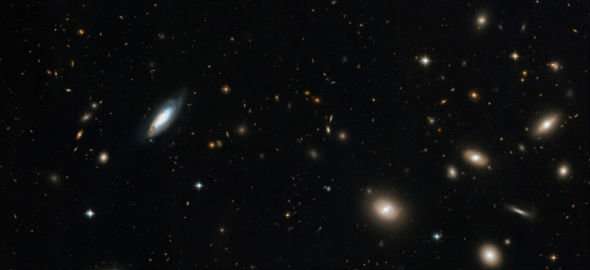Nearly a third of all galaxy clusters may have been previously unnoticed

In 1933, Fritz Zwicky, famous American astronomer of Swiss origin, arrived at the astonishing conclusion that even though galaxies are the signposts of galaxy clusters, their contribution to the total cluster mass is minuscule in comparison to a dominant dark matter component. Current estimates of a cluster total mass indicates that the contributions are roughly:
- galaxies: 1 percent
- hot intracluster gas: 9 percent
- dark matter: 90 percent.
Until now, these megaparsec-scale systems, which have up to hundreds of trillions of solar masses, were easily recognized in visible light because of the brightness of the embedded galaxies and their concentration toward the cluster centers. Because of their large masses and extent, galaxy clusters are fundamental to the mapping and mass budget of the universe. New work by an international team of scientists suggests that perhaps as many as a third of all clusters have previously been unobserved. The study, conducted in the nearby universe, shows that the newly revealed clusters contain fewer, less packed, and less luminous galaxies in comparison to the conventional clusters.
The discovery was made using public data for 191,440 galaxies from a major galaxy redshift survey (the 2dFGRS) conducted a decade ago with a robotic instrument at the 3.9-meter Anglo-Australian Telescope. The re-examination of the data through big data analysis, along with the abandonment of prejudices on cluster appearance, led to the reported discovery.
The international team of astronomers and computer scientists showed that not all the clusters (or swarms) of galaxies look the same in the optical range. "We have found clusters with fewer and less luminous galaxies (spirals and irregulars) and more loosely packed toward the centers than the conventional clusters, properties that superficially give them an appearance not too dissimilar from ordinary regions of the sky. This is the main reason why they were unnoticed until now," explains Luis Campusano from the University of Chile in Santiago and lead author of the study.
"The result is as surprising as if geographers had missed a third of the high peaks in a mountain range such as the Andes because they had snow and were a bit flatter on their tops," adds Roger G. Clowes from the Jeremiah Horrocks Institute of the University of Central Lancashire, England, co-author of the article.
The discovery of a new class of massive clusters has important consequences. "So far, the searches of clusters were based on the presence of bright elliptical galaxies, while the addition of new massive clusters increases their contribution to the mean mass of the universe. The realization that clusters of similar mass can have quite different galaxy content is evidence that the particular history of each cluster is also relevant, and not simply its mass alone. The result poses new constraints to the theory of galaxy evolution," states Gabriel Marinello from the Joint ALMA Observatory, also co-author of this work.
The clue that allowed Campusano and his collaborators to find new large systems of "dark matter" was the implementation of a cluster finder that considered only the spatial distribution of the galaxies without concern for their brightness or for their morphology. The teamwork between astronomers and computer scientists was also fundamental.
The software identified clusters in the database, which contains the positional information for nearly 200,000 galaxies, by a geometric method that finds the galaxy overdensities. This allows the identification of a cluster´s members through a velocity-gap that separates them from the general sky field. The resulting cluster sample proved to contain clusters reported in the literature and to provide a more complete cluster catalog.
Most cluster-finder algorithms rely on the proximity between galaxies, the so-called friends-of-friends method, which can blur the identification of the cluster core. In a comparison with the published results from other, earlier cluster finders working on the same galaxy dataset, the effectiveness of the new computational procedure was shown to be substantially improved. Through detailed analyses, the authors showed that the new algorithm was not only able to detect the already-published clusters, but that it also revealed new clusters. It turned out that some of the new detections were "more of the same," which is unsurprising when improved methods are used. But many were revealed to have a different appearance. The detailed analysis of these extra detections led to the discovery.
Arguably, the science of galaxy clusters started as early as 1781 with visual identification of overdensities in the distribution of nebulae over large areas of the sky by the French astronomer Messier. However, only relatively recently, in 1923, were some of the nebulae first recognized as external galaxies by Edwin Hubble.
More information: Luis E. Campusano et al. A 3D Voronoi+Gapper Galaxy Cluster Finder in Redshift Space to z ∼ 0.2. II. An Abundant Cluster Population Dominated by Late-type Galaxies Unveiled, The Astrophysical Journal (2018). DOI: 10.3847/1538-4357/aaeff3
Journal information: Astrophysical Journal
Provided by CATA





















